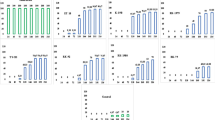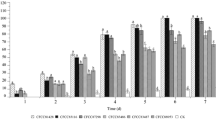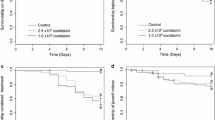Abstract
The pine processionary caterpillar,Thaumetopoea pityocampa is the most important defoliator of both native and introduced pines throughout Italy and is especially damaging in young plantations and on ornamental trees. A number of microbial pathogens have been isolated from larvae and pupae over the last 30 years. Some of them have been evaluated as biological control agents, and have provided encouraging results. However, onlyBacillus thuringiensis var.kurstaki (Btk) has passed the experimental screening and is now available for routine treatments, although its application by air is subjected to strict regulation by the government. The erratic performance of a single application ofBtk againstT. pityocampa that has been observed in the field (20–85% mortality) is related to a great variability in both the application dose and some population parameters ofT. pityocampa. The emergence period of adults varies from July (Alps) to October (South) and its duration is related to the spreading of the cohorts (individuals with different length of prolonged diapause) over time. In addition, embryonic development takes from 20 to 45 days, depending strictly on the temperatures recorded in the egg masses. As a result, the most vulnerable larval instars (L1 and L2) are never thoroughly reached by one application only, as the persistence of the bacteria on the needles is usually limited. Two applications are requested to control the pest in stands where the egg hatching occurs over more than one month. Another possibility consists of a single winter application against L3−L4 with a higher dose, to be performed where a certain amount of damage is tolerated.
Similar content being viewed by others
References
Ambrosi, P.;Salvadori, C.;Zanotelli, L., 1993: Primi risultati sull’impiego del mezzo aereo nella lotta alla processionaria del 3 pino.Boll. ISMA3,55–57.
Androic, M., 1956: Contribution a l’étude deCnethocampa 2 pityocampa Schiff. Rev. Pathol. vég. Ent. agric. France35, 251–262.
Battisti, A., 1988: Host-plant relationships and population dynamics of the Pine Processionary CaterpillarThaumetopoea pityocampa (Denis & Schiffermüller). J. Appl. Ent.105, 393–402.
Battisti, A., 1989: Field studies on the behaviour of two egg parasitoids of the Pine Processionary MothThaumetopoea pityocampa. Entomophaga34, 29–38.
Battisti, A.;Longo, S.;Tiberi, R., 1991: Aggiornamento delle conoscenze sulla processionaria del pino in Italia. In: Atti giornate di studio sulle avversità del pino. Ed. byGovi, G.;Masutti, L., Regione Emilia Romagna, Bologna, 185–193.
Bernardi, M.;Ghiraldo, C.;Battisti, A., 1995: L’Upupa 2Upupa epops quale fattore di regolazione delle popolazioni di Processionaria del pinoThaumetopoea pityocampa. Avocetta19, 129.
Biliotti, E., 1959: Observations épizootiologiques sur la processionnaire du pin. Rev. Pathol. vég. Ent. agric. France38, 149–155.
Currado, I.;Brussino, G., 1985: Esperienze di lotta conBacillus thuringiensis Berl. nelle foreste del Piemonte. La difesa delle piante2, 339–344.
De Bellis, E.;Cavalcaselle, B., 1969: Trattamento aereo con ilBacillus thuringiensis Berliner contro le larve della processionaria del pino. Notiz. Mal. Piante80–81, 159–168.
Démolin, G., 1969a: Bioecologia de la procesionaria del pinoThaumetopoea pityocampa Schiff. Incidencia de los factores climaticos. Bol. Serv. Plagas For.12, 9–24.
Démolin, G., 1969b: Comportement des adultes deThaumetopoea pityocampa. Dispersion spatiale, importance écologique. Ann. Sci. For.26, 81–102.
Démolin, G.;Millet, A., 1981: Essais insecticides contre la Processionnaire du Pin (Thaumetopoea pityocampa Schiff). Action comparative de différentes spécialités commerciales Bactospéine, Dipel, Thuricide et Dimilin. Ann. Sci. For.38, 389–404.
Démolin, G.;Martin, J.-C.;Lavanceau, P., 1993: Lutte contre la Processionnaire du Pin. L’évolution des insecticides à base 3 deBacillus thuringiensis. Phytoma452, 13–16.
Démolin, G.;Abgrall, J. F.;Bouhot-Delduc, L., 1996: Evolution de l’aire de la processionnaire du pin en France. Les 3 cahiers du DSF1, 26–28.
D’Offria, E.;Galbero, G.;Furlan, G., 1996: Lotta biologica 2 control la processionaria del pino. Inf. Agr.52 (23), 57–58.
Halperin, J., 1990: Natural enemies ofThaumetopoea spp. (Lep., Thaumetopoeidae) in Israel. J. Appl. Ent.109, 425–435.
Harpaz, I.;Zlotkin, E.;Ben-Shaked, Y., 1965: On the pathology of cytoplasmic and nuclear polyedrosis of the Cyprus processionary caterpillarThaumetopoea wilkinsoni Tams. J. Invert. Pathol.7, 15–21.
IPCC, 1995: Climate change 1995—The Science of Climate Change. Contribution of Working Group I to the Second Assessment Report of the Intergovernmental Panel of Climate Change. Ed. byHoughton, J. J.; Meiro Filho, L. G.; Callander, B. A.; Harris, N.; Kattenberg, A.; Maskell, K., Cambridge UK.
Johnson, K. S.;Scriber, J. M.;Nitao, J. K.;Smitley, D. R., 1995: Toxicity ofBacillus thuringiensis var.kurstaki to three nontarget Lepidoptera in field studies. Env. Entomol.24, 288–297.
Masutti, L.;Battisti, A., 1990:Thaumetopoea pityocampa (Den. & Schiff.) in Italy. Bionomics and perspectives of integrated control. J. Appl. Ent.110, 229–234.
Niccoli, A.;Tiberi, R., 1985: Impiego diBacillus thuringiensis Berliner nel controllo di insetti dannosi in ambienti agrari e forestali. Redia68, 305–322.
Paparatti, B.;Fabozzi, R., 1988: Un nuovo parassita della processionaria del pino (Thaumetopoea pityocampa [Den. et Schif.], Lepidoptera: Thaumetopoeidae). Inf. Fitopat.38(9), 45–48.
Pelagatti, O., 1988: Microrganismi appartenenti al genereBacillus spp. isolati da insetti. Redia71, 11–20.
Pelagatti, O.;Del Frate, G.;Picco, A.;Caretta, G., 1993: Fungi associated with insects found in various Italian environments: further observations. Redia76, 169–178.
Robredo, F., 1963: Las procesiones de crisalidacion deThaumetopoea pityocampa Schiff. Bol. Serv. Plagas For6, 122–130.
Ruperez, A., 1969: Microorganismos patogenos paraThaumetopoea pityocampa Schiff. y su utilizacion. Bol. Serv. Plagas For.12, 41–49.
Sidor, C.;Zamola, B.;Zega, A.;Dušanic, L., 1982: A disease of pine processionary (Thaumetopoea pityocampa) caused by a nuclear-type polyhedral virus. Redia65, 89–95.
Triggiani, O.;Sidor, C., 1982: Prove di controllo microbiologico della Processionaria del pino (Thaumetopoea pityocampa Schiff., Lepid. Thaumetopoeidae) nelle pinete in Puglia. Entomologica17, 91–102.
Triggiani, O.;De Lillo, E.;Addante, R., 1993: La Processionaria del Pino,Thaumetopoea pityocampa (Den. et Schiff.) (Lepidoptera: Thaumetopoeidae), e i suoi nemici naturali in Puglia. Entomologica27, 139–167.
Tzankov, G.;Encheva, L.;Kaitazova, P., 1979: Virus disease onThaumetopoea pityocampa Schiff. Gorsk. Nauka6, 68–72.
Vago, C., 1953: La polyédrie deThaumetopoea pityocampa. Ann. Épiphyt.3, 319–322.
Vago, C., 1958: Virose intestinale chez la Processionnaire du pinThaumetopoea pityocampa Schiff. (Lepidoptera). Entomophaga3, 35–37.
Author information
Authors and Affiliations
Rights and permissions
About this article
Cite this article
Battisti, A., Longo, S., Tiberi, R. et al. Results and perspectives in the use ofBacillus thuringiensis Berl. var.kurstaki and other pathogens againstThaumetopoea pityocampa (Den. et Schiff.) in Italy (Lep., Thaumetopoeidae). Anz. Schadlingskde., Pflanzenschutz, Umweltschutz 71, 72–76 (1998). https://doi.org/10.1007/BF02767109
Issue Date:
DOI: https://doi.org/10.1007/BF02767109




